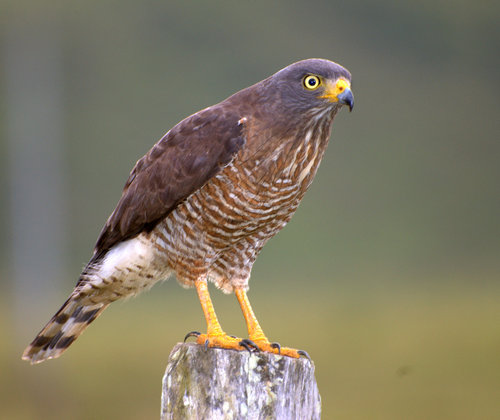
Roadside Hawk
The Roadside Hawk (*Rupornis magnirostris*) is a relatively small but widespread raptor found throughout much of Latin America. It is known for its adaptability, often seen perched on roadside posts and wires, hence its common name. This hawk plays a crucial role in controlling rodent and insect populations, making it an important part of the ecosystems it inhabits. While not globally threatened, it faces localized pressures from habitat loss and human activity. It holds no particular cultural significance that is widely documented, but its common presence makes it a familiar sight in many rural areas.
31-41 cm
Length
65-85 cm
Wingspan
Least Concern
Conservation Status
Distribution
The Roadside Hawk has an extensive range, spanning from northern Mexico south through Central America and most of South America, reaching as far as central Argentina. It is absent from Chile and some of the higher Andean regions. It does not undertake long-distance migrations, though some local movements may occur in response to food availability.
Lifespan
The lifespan in the wild is not well-documented but is estimated to be around 10-12 years. In captivity, they may live longer.
Roadside Hawk's Habitat
Habitat Types
Open woodlands, Savannas, Forest edges, Agricultural areas, Urban parks, Roadsides
Climate Zones
Tropical, Subtropical, Temperate
Adaptations
Its relatively small size and broad wings allow for maneuverability in varied habitats, from open fields to somewhat dense woodlands. Its tolerance of human-altered landscapes contributes to its widespread distribution.
Variations
Numerous subspecies (around 12) are recognized, differing primarily in plumage coloration and size, reflecting adaptations to local conditions across its vast range.
Appearance
Breeding Plumage
There is little to no difference in plumage between breeding and non-breeding seasons.
Seasonal Feather Changes
No significant seasonal plumage variation is observed.
Sex Based Plumage Differences
While both sexes have similar plumage patterns, females tend to have slightly more barring on the underparts, and the males have a more distinctive rufous coloring on the wings.
Notable Features
Relatively large bill for its size, Rufous patches on the wings (more prominent in males), Long, barred tail, Yellow cere and legs
Diet and Feeding
Primary Foods
Insects, Small reptiles (lizards, snakes), Small mammals (rodents), Birds (occasionally), Amphibians
Foraging Behavior
The Roadside Hawk is primarily a perch-and-wait predator. It sits on exposed perches, such as fence posts, utility poles, or tree branches, scanning the ground for prey. Once prey is spotted, it swoops down to capture it.
Specializations
Its sharp talons and strong beak are well-suited for capturing and consuming a variety of prey.
Seasonal Diet Variations
Diet can vary depending on prey availability. During the rainy season, insects may form a larger part of the diet, while in drier periods, they may rely more on reptiles and small mammals.
Behavior
Social Structure
Roadside Hawks are generally solitary or found in pairs, especially during the breeding season. They are not known to form large flocks.
Communication
A loud, piercing "kee-yer" call, Various other vocalizations during courtship and territorial defense, Visual displays, such as wing-flicking and tail-bobbing
Migration
Roadside Hawks are largely non-migratory, although some local movements may occur in response to food availability or seasonal changes.
Territorial or Group Behaviors
Roadside Hawks are territorial, defending their nesting and hunting areas from other raptors and conspecifics. Pairs will often perch together within their territory.
Conservation
Threats
Habitat loss (deforestation, urbanization), Pesticide use (affecting prey populations and potentially causing direct poisoning), Collisions with vehicles, Shooting (in some areas, perceived as a pest)
Protection Programs
General raptor protection laws in many countries, Some habitat conservation efforts indirectly benefit the species
Local National Laws
Protected under various national wildlife laws throughout its range, though enforcement varies.
Population Trend
Stable
Population Estimates
While precise global population estimates are difficult to obtain, the species is considered common and widespread.
Interesting Facts
They are one of the most commonly seen raptors in many parts of Latin America.
Their adaptability to human-modified landscapes and their habit of perching in open areas contribute to their high visibility.
The scientific name "magnirostris" means "large beak."
This refers to the Roadside Hawk's proportionally large bill compared to other hawks of similar size.
They have been observed using tools, dropping small stones on eggs to break them.
While rare, this behavior has been documented, demonstrating their intelligence.
Despite their small size, they are capable of taking prey as large as themselves.
This highlights their strength and hunting prowess.
Faqs about Roadside Hawk
Are Roadside Hawks dangerous to humans?
No, Roadside Hawks are not dangerous to humans. They are relatively small and primarily prey on small animals. They pose no threat unless directly threatened or protecting their nest.
What should I do if I find an injured Roadside Hawk?
If you find an injured Roadside Hawk, do not attempt to handle it yourself. Contact a local wildlife rehabilitation center or animal control agency for assistance. Consult a professional for expert advice.
Do Roadside Hawks migrate?
Roadside Hawks are generally non-migratory, remaining in the same general area year-round. However, some local movements may occur in response to changes in food availability.
What is the Roadside Hawk's call like?
The Roadside Hawk has a distinctive, high-pitched "kee-yer" call, often described as piercing and easily recognizable.
Copyright @ Nature Style Limited. All Rights Reserved.
 English
English